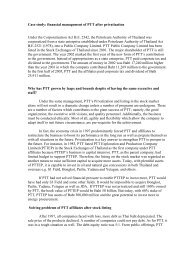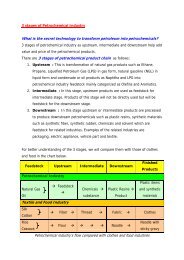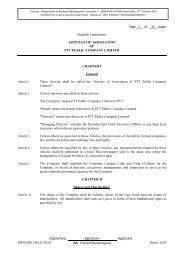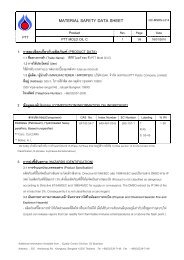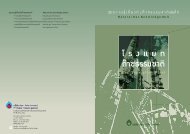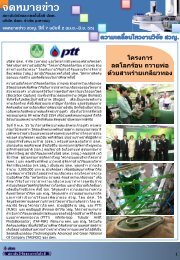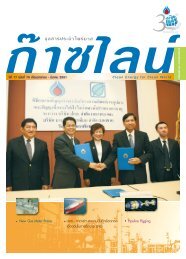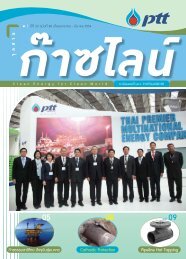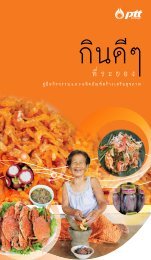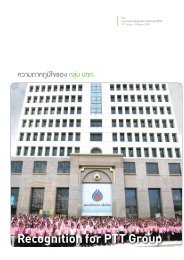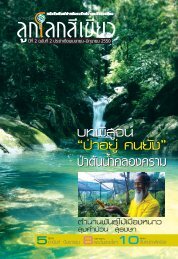PTT RTI Newsletter Vol.7 No.2 (April-June 2012)
PTT RTI Newsletter Vol.7 No.2 (April-June 2012)
PTT RTI Newsletter Vol.7 No.2 (April-June 2012)
Create successful ePaper yourself
Turn your PDF publications into a flip-book with our unique Google optimized e-Paper software.
<strong>Newsletter</strong><strong>PTT</strong> Research and Technology Institute<strong>PTT</strong> Public Company Limited<strong>PTT</strong> <strong>RTI</strong> <strong>Newsletter</strong> <strong>Vol.7</strong> <strong>No.2</strong> (Apr-Jun <strong>2012</strong>)<strong>PTT</strong> Public Company Limited (<strong>PTT</strong> PLC) and the Royal ChitraladaProjects undertook a collaborative research on “Global WarmingLessening for the Father with Spirulina” Project. In this regard, aresearch team from Environment Research and ManagementDepartment, <strong>PTT</strong> Research and Technology Institute (<strong>PTT</strong> <strong>RTI</strong>)has taken parts in designing, implementing and installing <strong>PTT</strong>’sinnovative pilot units.This collaborative project aims to conduct a research on theapplication of Spirulina Algae cultivated by the Royal ChitraladaProjects for biocarbon capture and production of biogas derivedfrom algae biomass to mitigate greenhouse effect and support thesearch for alternative energy for sustainable development. Aboveall, the program has been activated to celebrate the auspiciousoccasion of His Majesty the King’s 84 th Birthday Anniversary toshow Thai people’s loyalty and gratitude to the monarchy.On 9 May <strong>2012</strong>, HM the King designated HRH Princess MahaChakri Sirindhorn as his representative to observe and monitorthe Royal Chitralada Projects’ results. On this occasion, <strong>PTT</strong>’s TopExecutives led by Mr.Wichai Pornkeratiwat, Chief OperatingOfficer, Upstream Petroleum and Gas Business Group, togetherwith Mr.Peerapong Achariyacheevin, Senior Executive VicePresident, Gas Business Unit, Mr.Suchart Thevithivarak, ExecutiveVice President, Engineering & Project Management, Mrs.Ratanavalee Inochanon, Executive Vice President, <strong>PTT</strong> Researchand Technology Institute, and Mrs. Sarintip Vaewhongs, VicePresident, Environment Research and Management Department,had an auspicious opportunity to jointly present HRH PrincessMaha Chakri Sirindhorn the sum of THB 3,000,000 along with theProgress Report on <strong>PTT</strong> <strong>RTI</strong>’s R&D Projects , and <strong>PTT</strong> <strong>RTI</strong>’s R&DMission and Activities, in support of the research project.Additionally, <strong>PTT</strong> exhibition booth displaying the Spirulina Algaeproject’s progress, was set up at the event. At the exhibitionbooth, Dr.Kanatip Ratanachoo, Senior Engineer, Project Controland Contract Management Manager, and Mr.PanyameeSachakamol, Researcher, were honored to present HRH PrincessSirindhorn the results of the study and <strong>PTT</strong>’s Innovative PilotModel of Automated PhotoBioreactor (PBR), Airlift (AF-PBR) andinfinite-Loop Tubular-Airlift Photobioreactor (iTAF-PBR). Thisspecially-designed PhotoBioreactor was jointly developed by theresearch teams from <strong>PTT</strong> Engineering & Project Management, and<strong>PTT</strong> Research and Technology Institute, to promote thedeployment of sustainable development in response to <strong>PTT</strong>’sstrategy move “TAGNOC”- Technologically-Advanced and GreenNational Oil Company.Global WarmingLessening for theFather with Spirulina1
<strong>PTT</strong> <strong>RTI</strong> <strong>Newsletter</strong> <strong>Vol.7</strong> <strong>No.2</strong> (Apr-Jun <strong>2012</strong>)Advancing <strong>PTT</strong> Flex CNG ECU15 March <strong>2012</strong>- A researcher team from Energy Application Technique andEngine Lab Department, led by Mr.Tanes Sretainind, Specialist, departed to a<strong>PTT</strong> LCNG Station in Sarapee District, Chiang Mai, to bring LiquefiedCompressed Natural Gas (LCNG) back to be tested with the prototype of <strong>PTT</strong>Flex CNG ECU, which is expected to be a solution for the upcoming gas qualityvariation issue. Consequently, the performance and drivability test result of<strong>PTT</strong> Flex CNG ECU, was satisfactory at the first stage. The evidence suggested<strong>PTT</strong> Flex CNG ECU’s applicability to CNG with varied properties.Later, the team gave a warm welcome to Mr.Erwin Wijaya and his team fromPGN and PT. Arthindo Raya, a CNG Conversion Kits and Transport Company,Indonesia, who were interested in the product of <strong>PTT</strong> Flex CNG ECU, and alsopaid a test-cell visit at <strong>PTT</strong> Research and Technology Institute. Moreover, thevisitors had a chance to discuss with <strong>PTT</strong> researcher team on <strong>PTT</strong> Flex CNGECU’s application to CNG with varied properties that opened the door to <strong>PTT</strong>in enhancing international commercialization of the ECU product.Biogas Application Knowledge Shared at aBuddhist Meditation CenterRecently, Dr.Chatvalee Kalambaheti and Dr.Chalermchai Ruangchainikom,Researchers from Environment Research and Management Department, <strong>PTT</strong>Research and Technology Institute, have shared biogas application knowledgewith a Buddhist meditation center at Baan Suan Pyramid, Baanna District,Nakhon Nayok. Through this knowledge sharing, the system of biogasapplication was a uniquely - designed invention consisting of a digester,grinder, pressure gauge for monitoring methane gas. This particular feature ofsystem with a biogas collector placed on top of a digester, gives more spacewhile enhancing biogas production efficiency. In this regard, Dr.Chalermchai,the system instructor and demonstrator, was warmly welcomed and highlyappreciated by Ajarn Ubol and Ajarn Mongkol Supadaechaporn, Baan SuanPyramid’s owners, for <strong>PTT</strong>’s hospitality and assistance on the matter. Thebiogas application introduced to a community, could bring benefit to BaanSuan Pyramid through improving household waste management andconverting organic wastes into biogas.Pilot EV Charging Station Ready for R&DThe research team engaging in the Project of Pilot EV Charging Station, fromEnergy Application Technique and Engine Lab Department, accepted thedelivery of the construction work of the Pilot EV Charging Station fromSchneider (Thailand) Limited, the contractor, on 12 <strong>April</strong> <strong>2012</strong>. The Pilot EVCharging Station is used in a research on Vehicle Electrification with the threemodes supplying electricity to electric vehicles (EV) as follows : 1) NormalCharge, 2) Medium Charge and 3) Quick Charge, which is applicable to anelectric charge with Protocol Communication based on CHAdeMO Standard.In the meantime, the Pilot EV Charging Station is in the process of imagemodification prior to the official operation startup.2
<strong>PTT</strong> <strong>RTI</strong> <strong>Newsletter</strong> <strong>Vol.7</strong> <strong>No.2</strong> (Apr-Jun <strong>2012</strong>)Asphalt ConcreteAsphalt concrete is a kind of composite materials commonly used in construction projects such as road surfaces,parking lots, airfields and even the core for embankment dams. It comprises asphalt which is used as a binderand mineral aggregate. They are mixed together and then laid down in layers and compacted.The terms "asphalt/asphaltic concrete" and "bituminous asphalt concrete" are typically used only in engineeringand construction documents and literature. Generally, asphalt concrete pavements are often called just "asphalt".Mixing of asphalt and aggregate can be accomplished in various ways as follows.- Hot Mix Asphalt Concrete: It is produced by heating the asphalt to decrease its viscosity, and drying theaggregate to remove moisture from it prior to mixing. Mixing is generally performed with the aggregate at about1) 150 °C for virgin asphalt 2) 166 °C for polymer modified asphalt, and 3) 95 °C for the asphalt cement. InThailand, mixing temperature of modified asphalt cement, relevant to the standard of Thai Industrial StandardsInstitute – TIST 2156, is at about 170 O C. Hot mix is most commonly used on highly trafficked pavements.- Warm Mix Asphalt Concrete: It is produced by adding zeolites, waxes, asphalt emulsions, or even water tothe asphalt prior to mixing. This allows significantly lower mixing temperature to at about 110 O C and also pavingtemperatures. This results in lower consumption of fossil fuels and hence it helps to release less carbon dioxide,aerosols and vapors. Because of improved working conditions and lower paving-temperature, it leads to morerapid availability of the surface for use, which is important for construction sites with critical time schedules.-Cold Mix Asphalt Concrete: It is produced by emulsifying the asphalt in water with (essentially) surfactantprior to mixing with the aggregate. Asphalt is less viscous in the emulsified state and the mixture is easy to workand compact. It is the form of asphalt concrete commonly used as a patching material and on lesser traffic roads.-Cut-back Asphalt Concrete: It is produced by dissolving the asphalt in kerosene or another lighter fraction ofpetroleum prior to mixing with the aggregate. Asphalt is less viscous in dissolved state and the mixture is easy towork and compact. However, after the mixture is laid down the lighter fraction, volatile organic compounds,evaporates. Thus, cut-back asphalt has been largely replaced by asphalt emulsion.3
<strong>PTT</strong> <strong>RTI</strong> <strong>Newsletter</strong> <strong>Vol.7</strong> <strong>No.2</strong> (Apr-Jun <strong>2012</strong>)In addition, there are other ways to produce asphalt concrete such asmastic asphalt concrete and natural asphalt concrete. At present, warmmix asphalt is one of very interesting options since, with the decreasedproduction temperature, it leads to more rapid availability of the surfacefor use. The immediate benefit is the reduction in energy consumptionrequired by burning fuels and the additional benefit is the reducedemissions.There are several technologies that have been developed and used toproduce and improve the properties of warm mix asphalt. The addition ofa synthetic zeolite during mixing creates a foaming effect in the binder.Certain positive effects can be obtained by the use of organic additives, aFischer-Tropsch paraffin wax, or by plant production with an asphaltemulsion product, which uses a chemical additive technology and a“dispersed asphalt technology” delivery system.The developed technologies aim to reduce viscosity of the asphalt binderwhich allows the aggregate to be fully coated at a lower temperaturethan what is traditionally required in hot mix asphalt production.Sources:www.doh.go.th/spaw2/uploads/files/menu1/01/dhs409-49.pdfhttp://www.systematic.ro/2011/warm-mix-asphalt-technologies/http://en.wikipedia.org/wiki/Asphalt_concretehttps://engineering.purdue.edu/~ncaupg/Activities/2006/Presentations%20HMA%20Conf.%2006/warm%20mix%20asphalt%20NCUPG%2001-06-Hansen.pdf•Executive Vice President, <strong>PTT</strong> Research and Technology Institute•Vice President, Research Planning and Management Department•Vice President, Petroleum Products and Alternative Fuels Research Department•Vice President, Energy Application Technique and Engine Lab Department•Vice President, Process Technology Research Department•Vice President, Geo-science & Petroleum Engineering Research Department•Vice President, Environmental Research and Management DepartmentDownload <strong>PTT</strong> <strong>RTI</strong> <strong>Newsletter</strong> fromhttp://www.pttplc.com/en/about-ptt-research-technology-institute-knowledge.aspx4



